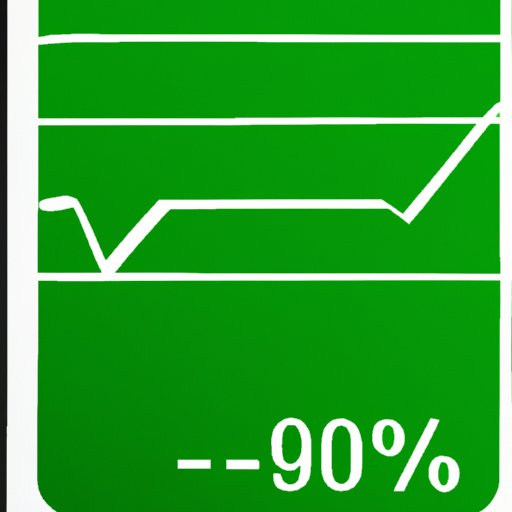
I. Introduction
Percent difference is a concept used to measure the difference between two values. It is an important tool in various industries such as science, finance, and engineering. Understanding how to calculate percent difference is crucial in making informed decisions in daily life. This comprehensive guide aims to explain the concept of percent difference, provide step-by-step guides on how to calculate it, and give real-life examples of its practical applications.
II. Understanding Percent Difference
Percent difference is defined as the absolute value of the difference between two values divided by the average of the two values, multiplied by 100. It measures the relative difference between two values as a percentage. The formula for percent difference is: percent difference = |(a – b) / ((a + b) / 2)| x 100.
Percent difference is used to compare two values and determine their relative difference. It is often used in situations where a change in value needs to be assessed, such as before and after measurements, or in comparing two similar products. Real-life examples of percent difference can be found in contexts such as comparing salaries, determining the efficiency of a machine, or evaluating the performance of an investment portfolio.
III. Calculating Percent Difference
The calculation of percent difference involves a few simple steps. First, determine the two values you wish to compare. Next, calculate the difference between these values, making sure to take the absolute value. Finally, divide this difference by the average of the two values, and multiply by 100 to get the percentage.
Real-life examples of percent difference include comparing a product’s cost from two different outlets, evaluating the efficiency of a machine by comparing output values before and after maintenance, or measuring the performance of an investment portfolio. When calculating percent difference, it is important to keep in mind the significance of the values being compared for real-world applications.
To make the calculation of percent difference easier, there are certain tips and tricks that can be useful. One such tip is to arrange the values in ascending or descending order to ensure consistency in the calculation. Another tip is to use an online percent difference calculator to save time and ensure accuracy in the calculation process.
IV. Practical Applications of Percent Difference
Percent difference is a versatile tool and is used in various fields. It is particularly useful in business and finance to compare financial metrics between different companies or time periods. For example, calculating percent difference between revenues of two different businesses or comparing the profit margins of the same company in distinct years can help make more informed decisions about investments.
In science and engineering, percent difference is applied to compare experimental values with theoretical results, or to calculate experimental error rates. Percent difference is essential in verifying the accuracy of scientific experiments by providing a relative error rate that can easily be understood.
Real-life applications of percent difference can be seen in comparing salaries between jobs, evaluating the efficiency of a machine by comparing its output values, or measuring the performance of an investment portfolio. These applications illustrate the versatility of percent difference in different contexts.
V. Comparison of Percent Difference to Other Similar Concepts
Percent difference is often confused with similar concepts such as percentage change and percentage error. Percentage change measures the relative change between two values, while percent difference measures the relative difference between two values. Percentage error is typically used to measure the error in an experimental value to a theoretical value, while percent difference is also used to compare experimental results with theoretical values.
It is important to distinguish between the different concepts and use the appropriate one depending on the circumstances. Percent difference is generally used to make comparisons between data points, while percentage change is used to assess the impact of a change in value. Percentage error, on the other hand, is used to measure the accuracy of experimental data.
VI. Common Pitfalls and Mistakes
When calculating percent difference, there are common mistakes that individuals tend to make. One mistake is to forget to take the absolute value of the difference, which can result in a negative percentage. Another potential mistake is miscalculating the average of the two values.
To avoid these mistakes, it is important to double-check all calculations and ensure consistency in them. It can also be beneficial to use an online calculator or a pre-defined formula to make the process easier and less prone to mistakes.
VII. Interactive Exercises
Interactive exercises can be particularly useful in helping readers understand concepts better and practice their problem-solving skills. Below are some practice problems to help readers practice calculating percent difference:
1. The cost of a pen is $1.50 at Store A and $1.75 at Store B. Calculate the percent difference in cost between the two stores.
2. The weight of a bookshelf is 80 lbs. After adding a new compartment, the weight increases to 95 lbs. Calculate the percent difference in weight.
VIII. Useful Tools
There are various useful tools that can simplify the process of calculating percent difference. Online calculators, such as those found on calculator.net or calculatorpro.com, can be beneficial in verifying calculations. Excel formulas can also be used to calculate percent difference, which can be particularly useful when dealing with large data points.
IX. Conclusion
Overall, percent difference is a versatile concept that has various practical applications in different fields. Understanding how to calculate percent difference is essential in making informed decisions in daily life. By following the step-by-step guide provided in this article, readers can master the calculation of percent difference and apply this knowledge to real-world scenarios. Remember to double-check calculations and use the appropriate tool for each specific situation to ensure consistency and accuracy.





